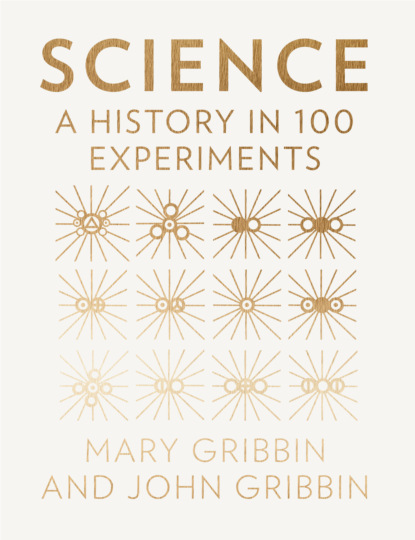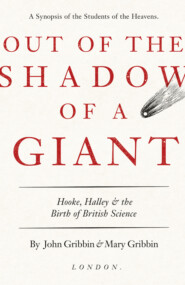По всем вопросам обращайтесь на: info@litportal.ru
(©) 2003-2024.
✖
Science: A History in 100 Experiments
Автор
Год написания книги
2019
Настройки чтения
Размер шрифта
Высота строк
Поля
77 THE FIRST NUCLEAR REACTOR (#litres_trial_promo)
78 THE FIRST PROGRAMMABLE COMPUTER (#litres_trial_promo)
79 DISCOVERING THE ROLE OF DNA (#litres_trial_promo)
80 JUMPING GENES (#litres_trial_promo)
81 THE ALPHA HELIX (#litres_trial_promo)
82 A BLEND OF DNA (#litres_trial_promo)
83 THE DOUBLE HELIX (#litres_trial_promo)
84 MAKING THE MOLECULES OF LIFE (#litres_trial_promo)
85 MASERS AND LASERS (#litres_trial_promo)
86 MAGNETIC STRIPES AND SEA-FLOOR SPREADING (#litres_trial_promo)
87 DETECTING THE GHOST PARTICLE (#litres_trial_promo)
88 A VITAL VITAMIN (#litres_trial_promo)
89 THE BREATHING PLANET (#litres_trial_promo)
90 THE ECHO OF THE BIG BANG (#litres_trial_promo)
91 CLOCKING ON TO RELATIVITY (#litres_trial_promo)
92 MAKING WAVES IN THE UNIVERSE (#litres_trial_promo)
93 THE PACEMAKER OF ICE AGES (#litres_trial_promo)
94 THE WORLD IS NON-LOCAL (#litres_trial_promo)
95 THE ULTIMATE QUANTUM EXPERIMENT (#litres_trial_promo)
96 THE ACCELERATING UNIVERSE (#litres_trial_promo)
97 MAPPING THE HUMAN GENOME (#litres_trial_promo)
98 FIFTEEN EQUALS THREE TIMES FIVE (#litres_trial_promo)
99 MAKING MATTER MASSIVE (#litres_trial_promo)
100 THE COMPOSITION OF THE UNIVERSE (#litres_trial_promo)
EXPERIMENT 101 (#litres_trial_promo)
REFERENCES (#litres_trial_promo)
INDEX (#litres_trial_promo)
ACKNOWLEDGEMENTS (#litres_trial_promo)
ABOUT THE AUTHORS (#litres_trial_promo)
ABOUT THE PUBLISHER (#litres_trial_promo)
© NASA/Science Photo Library
Astronaut working on the Hubble Space Telescope (HST) during a routine servicing mission.
© Caltech/MIT/Ligo Labs/Science Photo Library
LIGO gravitational wave detector. Aerial photograph of the Livingston detector site for the Laser Interferometer Gravitational-Wave Observatory (LIGO). LIGO compares measurements between two detector sites 3000 kilometres apart, one near Hanford, Washington, USA, and the other near Livingston, Louisiana, USA. Each site is an L-shaped ultra-high vacuum system, four kilometres long on each side. Laser interferometers are used to look for small changes caused by gravitational waves. LIGO has been operating since 2002, with an advanced upgrade (aLIGO) operating since 2015. On 11 February 2016 it was announced that gravitational waves had been detected by LIGO. The signal was detected on 14 September 2015, and was the result of two black holes colliding.
INTRODUCTION (#ulink_2aee0af2-71e6-5ee5-b227-423ca17516d1)
Science is nothing without experiments. As the Nobel Prize-winning physicist Richard Feynman said: ‘In general, we look for a new law by the following process: First we guess it; then we compute the consequences of the guess to see what would be implied if this law that we guessed is right; then we compare the result of the computation to nature, with experiment or experience [observation of the world], compare it directly with observation, to see if it works. If it disagrees with experiment, it is wrong. In that simple statement is the key to science. It does not make any difference how beautiful your guess is, it does not make any difference how smart you are, who made the guess, or what his name is — if it disagrees with experiment, it is wrong.’
© Physics Today Collection/American Institute of Physics/Science Photo Library
American physicist Richard Feynman (1918–1988).
Those words – if it disagrees with experiment, it is wrong – provide the simplest summary of what science is all about. People sometimes wonder why it took so long for science to get started. After all, the Ancient Greeks were just as clever as us, and some of them had both the curiosity and the leisure to philosophize about the nature of the world. But, by and large, with a few exceptions, that is all they did – philosophise. We do not intend to denigrate philosophy by this remark; it has its own place in the roll of human achievements. But it is not science. For example, these philosophers debated the question of whether a light object and a heavy object dropped at the same time would hit the ground at the same time, or whether the heavier object would fall more quickly. But they did not test their ideas by dropping objects with different weights from the top of a tall tower; that experiment would not be carried until the seventeenth century (although not, as we shall explain, by Galileo; see here (#u80afdc06-b83a-572c-8d1c-c85f70fc0a5a)). Indeed, it was just at the beginning of the seventeenth century that the English physician and scientist* (#ulink_af8827d5-4b17-5d1a-8f60-bf0f12203f43) William Gilbert (see here (#u68ccc399-6d30-52d8-914f-c3f0025c67b3)) first spelled out clearly the scientific method later summed up so succinctly by Feynman. In 1600, writing in his book De Magnete, Gilbert described his work, notably concerning magnetism, as ‘a new kind of philosophizing’, and went on: ‘If any see fit not to agree with the opinions here expressed and not to accept certain of my paradoxes, still let them note the great multitude of experiments and discoveries … we have dug them up and demonstrated them with much pains and sleepless nights and great money expense. Enjoy them you, and if ye can, employ them for better purposes … Many things in our reasonings and our hypothesese will perhaps seem hard to accept, being at variance with the general opinion; but I have no doubt that hereafter they will win authoritativeness from the demonstrations themselves.’
© National Library of Medicine/Science Photo Library
William Gilbert (1544–1603), English physician and physicist. In 1600 Gilbert published De Magnete (Concerning Magnetism), a pioneering study in magnetism, which contained the first description of the scientific method, and greatly influenced Galileo.
In other words, if it disagrees with experiment, it is wrong. The reference to ‘great money expense’ also strikes a chord in the modern age, when scientific advances seem to require the construction of expensive instruments, such as the Large Hadron Collider at CERN, probing the structure of matter on the smallest scale, or the orbiting automatic observatories that reveal the details of the Big Bang in which the Universe was born. This highlights the other key to the relatively late development of science. It required (and requires) technology. There is, in fact, a synergy between science and technology, with each feeding off the other. Around the time that Gilbert was writing, lenses developed for spectacles were adapted to make telescopes, used to study, among other things, the heavens. This encouraged the development of better lenses, which benefited, among other things, people with poor eyesight.
A more dramatic example comes from the nineteenth century. Steam engines were initially developed largely by trial and error. The existence of steam engines inspired scientists to investigate what was going on inside them, often out of curiosity rather than any deliberate intention to design a better steam engine. But as the science of thermodynamics developed, inevitably this fed back into the design of more efficient engines. However, the most striking example of the importance of technology for the advancement of science is one that is far less obvious and surprises many people at first sight. It is the vacuum pump, in its many guises down the ages. Without efficient vacuum pumps, it would have been impossible to study the behaviour of ‘cathode rays’ in evacuated glass tubes in the nineteenth century, or to discover that these ‘rays’ are actually streams of particles – electrons – broken off from the supposedly unbreakable atom. And coming right up to date, the beam pipes in the Large Hadron Collider form the biggest vacuum system in the world, within which the vacuum is more perfect than the vacuum of ‘empty’ space. Without vacuum pumps, we would not know that the Higgs particle (see here (#litres_trial_promo)) exists; in fact, we would not have known enough about the subatomic world to even speculate that such an entity might exist.
© Science Source/Science Photo Library
Robert Hooke’s hand-crafted microscope.
But we know that atoms and even subatomic particles exist, in a much more fundamental way than the Ancient Greek philosophers who speculated about such things, because we have been able (and, equally significantly, we have been willing) to carry out experiments to test our ideas. The ‘guesses’ that Feynman refers to are more properly referred to as hypotheses. Scientists look at the world around them, and make hypotheses (guesses) about what is going on. For example, they hypothesise that a heavy object and a lighter object dropped at the same time will hit the ground at different times. Then they drop objects from a high tower, and find that the hypothesis is wrong. There is an alternative hypothesis: that heavy and light objects fall at the same rate. Experiment proves that this is correct, so this hypothesis gets elevated to the status of a theory. A theory is a hypothesis that has been tested by experiment and passed those tests. Human nature being what it is, of course, it is not always so straightforward and clear cut. Adherents to the failed hypothesis may try desperately to find a way to shore it up and explain things without accepting the experimental evidence. But in the long run, the truth will out – if only because the die hards really do die.
Non-scientists sometimes get confused by this distinction between a hypothesis and a theory, not least because many scientists are guilty of sloppy use of the terminology. In everyday language, if I have a ‘theory’ about something (such as the reason why some people like Marmite and others don’t) this is really just a guess, or a hypothesis; this is not what the word ‘theory’ means in science. Critics of Darwin’s theory who do not understand science sometimes say that it is ‘only a theory’, with the implication ‘my guess is as good as his’. But Darwin’s theory of natural selection starts from the observed fact of evolution, and explains how evolution occurs. In spite of what those critics might think, it is more than a hypothesis – not just a guess – because it has been tested by experiment, and has passed those tests. Darwin’s theory of evolution by natural selection is ‘only’ a theory in the same way that Newton’s theory of gravity is ‘only’ a theory. Newton started from the observed facts of the ways things fall or orbit around the Earth and the Sun, and developed an idea of how gravity works – gravity involving an inverse square law of attraction. Experiments (and further observations, which throughout this book we include under the heading ‘experiments’) confirmed this.
© Paul D. Stewart/Science Photo Library
Charles Darwin’s illustration, from his book Fertilisation of Orchids, of Cypripedium (slipper orchid, Paphiopedilum), beneath a photograph of an early variety of Sandford orchid cultivar.
Gravity provides another example of how science works. Newton’s theory passed every test at first, but as observations improved it turned out that the theory could not explain certain subtleties in the orbit of Mercury, the closest planet to the Sun, which orbits where gravity is strong – that is, where there is a strong gravitational field. In the twentieth century, Albert Einstein came up with an idea, which became known as the general theory of relativity, that explained everything that Newton’s theory explained, but which also explained the orbit of Mercury and correctly predicted the way light gets bent as it passes near the Sun (see here (#litres_trial_promo)). Einstein’s theory is still the best theory of gravity we have, in the sense that it is the most complete. But that does not mean that Newton’s theory has to be discarded. It still works perfectly within certain limits, such as in describing how things move under the influence of gravity in less extreme circumstances, in the so-called ‘weak field approximation’, and is fine for calculating the orbit of the Earth around the Sun, or for calculating the trajectory of a spaceprobe sent to rendezvous with a comet.






